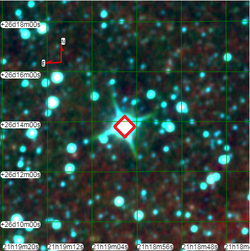HD 203030
| Observation data Epoch J2000.0 Equinox J2000.0 (ICRS) | |
|---|---|
| Constellation | Vulpecula |
| Right ascension | 21h 18m 58.2198s[1] |
| Declination | 26° 13′ 49.9562″[1] |
| Apparent magnitude (V) | 8.426[1] |
| Characteristics | |
| HD 203030 | |
| Evolutionary stage | main sequence star |
| Spectral type | K0V |
| B−V color index | 0.78 |
| V−R color index | -0.364 |
| Astrometry | |
| Radial velocity (Rv) | -16.651±0.0024[1] km/s |
| Proper motion (μ) | RA: 133.593±0.108 [1] mas/yr Dec.: 9.563±0.11 [1] mas/yr |
| Parallax (π) | 25.4488 ± 0.061 mas[1] |
| Distance | 128.2 ± 0.3 ly (39.29 ± 0.09 pc) |
| Details | |
| HD 203030 | |
| Mass | 0.965±0.035[2] M☉ |
| Age | 0.1+0.05 −0.07[3] Gyr |
| Other designations | |
HIP 105232, LTT 4041, TYC 2190-1095-1, UBV 18409, 2MASS J21185820+2613500, Gaia DR2 1846882224145757056 | |
| Database references | |
| SIMBAD | data |
| Exoplanet Archive | data |
HD 203030 is a single orange (K-type) main-sequence , located approximately 128 light-years away in the constellation of Vulpecula, taking its primary name from its Henry Draper Catalogue designation.
History and nomenclature
The designation HD 203030 is from the Henry Draper Catalogue, which is based on spectral classifications made between 1911 and 1915 by Annie Jump Cannon and her co-workers, and was published between 1918 and 1924.
Characteristics
HD 203030 is a Sun-like K-type main-sequence star. It is likely very young, belonging to 45 million years old IC 2391 open cluster.[3]
Planetary system
In 2006, a direct imaging have discovered what was believed to be a brown dwarf of spectral class L7.5 at the projected separation 487.1±1.8 AU.[4] The companion was proven to be in the bound orbit by 2014.[2] In 2017, the planetary system reanalysis have indicated what the star HD 203030 is probably very young, and therefore both the primary and the observed companion is less massive than previously thought, placing the companion object within planetary definition.[3] In 2019, the rotational period of HD 203030 B was measured to be equal to 7.5+0.6
−0.5 hours, and patchy cloud cover was detected.[5]
| Companion (in order from star) |
Mass | Semimajor axis (AU) |
Orbital period (days) |
Eccentricity | Inclination | Radius |
|---|---|---|---|---|---|---|
| B | 11+4 −3 MJ |
487 | — | — | — | — |
See also
References
- ^ a b c d e f g HD 203030, entry, SIMBAD. Accessed online June 2, 2020.
- ^ a b Ginski, C.; Schmidt, T. O. B.; Mugrauer, M.; Neuhäuser, R.; Vogt, N.; Errmann, R.; Berndt, A. (2014). "Astrometric follow-up observations of directly imaged sub-stellar companions to young stars and brown dwarfs★". Monthly Notices of the Royal Astronomical Society. 444 (3): 2280–2302. arXiv:1409.1850. Bibcode:2014MNRAS.444.2280G. doi:10.1093/mnras/stu1586. S2CID 119118750.
{{cite journal}}: CS1 maint: unflagged free DOI (link) - ^ a b c d Miles-Páez, Paulo A.; Metchev, Stanimir; Luhman, Kevin L.; Marengo, Massimo; Hulsebus, Alan (2017). "The Prototypical Young L/T-Transition Dwarf HD 203030B Likely Has Planetary Mass". The Astronomical Journal. 154 (6): 262. arXiv:1710.11274. Bibcode:2017AJ....154..262M. doi:10.3847/1538-3881/aa9711. S2CID 67821107.
{{cite journal}}: CS1 maint: unflagged free DOI (link) - ^ Metchev, Stanimir A.; Hillenbrand, Lynne A. (2006). "HD 203030B: An Unusually Cool Young Substellar Companion near the L/T Transition". The Astrophysical Journal. 651 (2): 1166–1176. arXiv:astro-ph/0607514. Bibcode:2006ApJ...651.1166M. doi:10.1086/507836. S2CID 16571973.
- ^ Miles-Páez, Paulo A.; Metchev, Stanimir; Apai, Dániel; Zhou, Yifan; Manjavacas, Elena; Karalidi, Theodora; Lew, Ben W. P.; Burgasser, Adam J.; Bedin, Luigi R.; Cowan, Nicolas; Lowrance, Patrick J.; Marley, Mark S.; Radigan, Jacqueline; Schneider, Glenn (2019). "Cloud Atlas: Variability in and out of the Water Band in the Planetary-mass HD 203030B Points to Cloud Sedimentation in Low-gravity L Dwarfs". The Astrophysical Journal. 883 (2): 181. arXiv:1908.09403. Bibcode:2019ApJ...883..181M. doi:10.3847/1538-4357/ab3d25. S2CID 201696377.
{{cite journal}}: CS1 maint: unflagged free DOI (link)

